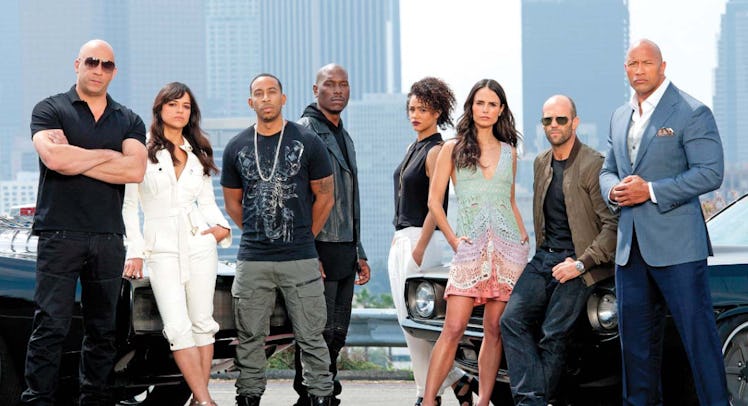The Fast and the Furious and the Clinical Psychologist
We watched "Fate of the Furious" then talked to a clinical psychologist. It was an interesting conversation.

The Fast and the Furious franchise is not just about cars defying the laws of physics. It’s about a non-nuclear (non-traditional, what have you) family overcoming obstacles on the way to international box office domination. Fans know this because Dom Toretto (Vin Diesel) loves to talk about family. He says family a lot or rather grumbles it like a Dodge Charger with a faulty muffler. And, from a clinical psychology perspective, the dude has a point. “There’s much more adherence to the family structure,” Dr. John Mayer says of non-nuclear families. The Fast Family is, in other words, non-traditional in composition and deeply traditional in structure.
Dom is Dad, Tyrese is a very handsome child, and Ludacris might be the dog.
“The rules of a family will play out in a family of adults,” says Mayer. “There tend to be childlike characters, while the leaders adopt a mother or father-like role. They don’t have to be called mom or dad, but one person will be more maternal or the provider, and maybe even disciplinary.”
And if that wasn’t rigid enough, the structure of the group has been hardened and strengthened by experience. Sixteen years ago when Dom and Brian O’Connor (Paul Walker) emptied their NOS tanks on the streets, they formed the building blocks of their family, but everything that happened afterward — driving out of planes, fucking up Rio de Janeiro, The Rock — has made that crew a tighter unit.
“People bond when they experience something highly emotional together, and they realize they want to be around each other,” says clinical and forensic psychologist Dr. John Paul Garrison. “And I don’t mean that in a romantic sense. During traumatic events, we release hormones and neurochemicals that draw us closer together.”
So when Luke Hobbs (Dwayne Johnson) is jumping out of a moving plane and into a car driven by Tej Parker (Ludacris) they’re actually bonding on an emotional level. Garrison is quick to add — lest the point sound ridiculous — that this is why soldiers and police often feel like brothers. In terms of neurochemistry, they essentially are. It may also be why (Johnson, Diesel beef aside) the cast of the franchise has always exhibited an unusual closeness.
“They’re all raw with each other,” says Mayer. “They’re totally raw because they’ve gone to battle together. It creates an extreme trust. I deal with first responder families all the time and these people are bonded because of the hardships of work.”
If that sounds bad, it’s not. Relationships built on choice and common experience are often unusually strong. There is a reason that there are two common forms of sitcoms, family and office: They are essentially the same show. It’s not a bad thing when coworkers — the Fast family is, in a sense, a consulting firm — begin to consider each other family.
“It’s a very healthy relationship,” says Mayer, adding the caveat that there is a point past which stuff starts getting weird.
For the Fast Franchise that point is The Fate of the Furious, in which family leader Dom goes rogue and teams up with cyber-terrorist Cipher (Charlize Theron). Garrison argues that Dom’s actions might not be a result of plot twists. Ultimately, it might be about emotional fatigue.
“If there’s been enough intensity, it takes a toll,” he says.
That may be, but with two sequels in the works, Dom and the gang may be as invested in each other as ever. Not even Charlize Theron can tear an alternative family apart.
This article was originally published on